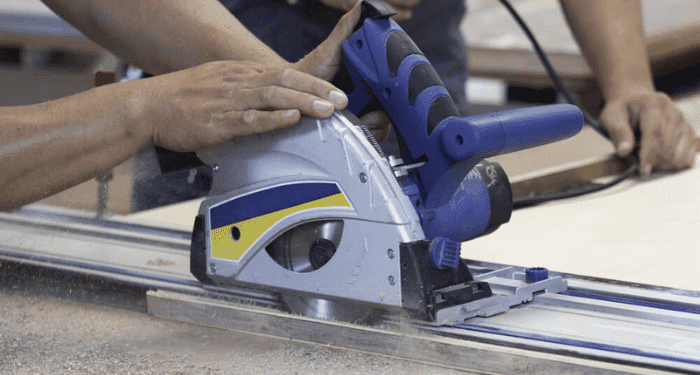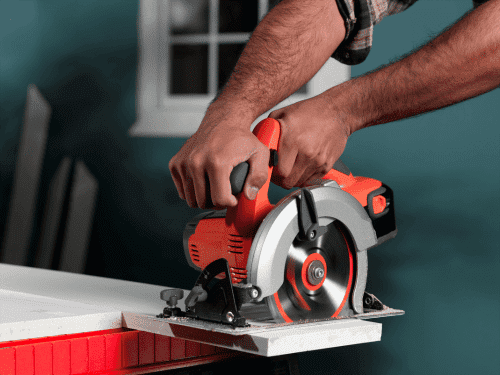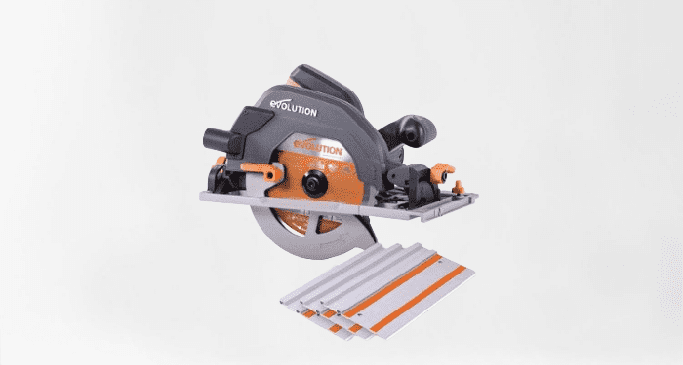YOUR NO 1 WOODWORKING POWER TOOLS RESOURCE WEBSITE
Plunge Saw vs Circular Saw: Which is Right For Your Projects?

Disclosure: If you click on some of the links, we may earn a small referral fee. Please know that we only recommend products that we use and believe will add value to our readers.
Struggling to choose between a plunge saw and a circular saw for your wood projects? Do you find yourself uncertain about which saw would be more suitable and beneficial for your specific needs?
It can be frustrating and time-consuming to research and compare the features, advantages, and applications of these two saws.
Don’t worry! In this comprehensive article, we will break down the differences between a plunge saw and a circular saw. We will explore their unique features, discuss the benefits they offer, and provide recommendations to help you make an informed decision.
Plunge Saw vs Circular Saw (Summary)
|
Factor |
Plunge Saw | Circular Saw | |
|
Precision |
Offers precise cuts | Requires additional measures | |
|
Cutting depth |
Greater cutting depth | Slightly shallower cutting depth | |
|
Bevel Capacity |
Limited | High | |
|
Ease of use |
Often used with guide rails | Suitable for beginners | |
|
Portability |
Less portable | More portable | |
|
Dust extraction |
Efficient dust extraction systems | Requires additional measures | |
|
Application |
For precise and clean cuts | Suitable for a wide range of applications |
Plunge Saw (Track Saw) – An Overview
The plunge saw also known as the track saw, is designed with a special shoe that runs along a guide rail, allowing for precise and straight cuts without the need for clamps or additional setup time. It has an enclosed blade, ensuring safety during operation and providing better control over the cutting process.
Many plunge saws are equipped with anti-kickback mechanisms, such as riving knives, to prevent the material from pinching the blade and reduce the risk of accidents. Dust collection ports and covers are often integrated into plunge saws, promoting cleaner working environments and improved visibility of the cut line.
Relevance of Plunge Saws To Woodworking Projects

Perfect Straight Cuts
The guide rail system of a plunge saw enables exceptionally accurate and splinter-free cuts. It eliminates the need for additional measuring and clamping, ensuring consistent results every time.
Ease of Set-up
With a plunge saw, setting up for a cut is quick and straightforward. Simply mark your cut line, align the guide rail, and make the plunge, saving time and effort.
Versatile Plunge Cutting
A plunge saw allows you to make plunge cuts at any point along the material, rather than just from the edge. This feature is especially useful for tasks like creating precise cutouts or dado joints.
Our Plunge Saw Recommendations
Here are our top picks based on their performance, features, and overall value for money.
The 6-1/2-inch, 48-tooth ATB cross-cutting saw blade that is included with the tool makes precise cuts on a variety of materials, including wood, plywood, and solid surfaces. It has a zero-clearance track to guarantee straight cuts without splinters or tear-out, an anti-kickback feature to lessen injury risks and guarantee operator safety, and a dust port that can be attached to a vacuum to keep the workspace clean.
2. Makita SP6000J1 Track Saw Kit
This Makita Track Saw Kit is another fantastic option that stands out in terms of quality and functionality. This kit includes not only the track saw but also a stackable tool case and a 55″ guide rail for added convenience and versatility. The plunge saw itself boasts a powerful motor, constant speed control, and an easy blade-change system for efficient and precise cutting. Its tracking adjustment feature ensures a perfect fit with the guide rail, resulting in exceptional accuracy.
Suggested Article: 9 Best Track Saws For The Money (Updated For 2024)
Circular Saw – An Overview
Now let’s shift our focus to the circular saw.
The circular saw, which can be seen as a table saw alternative is a versatile and portable power tool used for cutting a wide range of materials such as wood, plastic, metal, concrete, bricks, and tiles. It utilizes a circular blade with sharp teeth that rotates at high speeds to make both curvilinear and straight cuts. The blade of a circular saw is exposed during operation, unlike the enclosed blade of a plunge saw.
Types of Circular Saws
Sidewinder Circular Saw
Also known as a direct-drive or traditional circular saw, the sidewinder circular saw features a motor mounted alongside the blade, resulting in a compact and lightweight design. This type of circular saw is known for its maneuverability and is suitable for general-purpose cutting tasks.
Worm Drive Circular Saw
The worm drive circular saw has a motor positioned behind the blade, allowing for increased torque and power. This design is often favored by professionals for heavy-duty cutting applications, such as framing and construction work.
Relevance of Circular Saws in Woodworking Projects

Circular saws are widely used in woodworking projects due to their versatility and ability to handle various materials. They are commonly used for tasks such as cutting timbers, ripping beams, framing materials, cutting decking, and shaping plywood.
Circular saws offer flexibility as they can be equipped with different types of blades depending on the material being cut. This adaptability allows woodworkers to achieve different finishes and meet specific project requirements.
Below are other articles comparing the circular saw with other power saws:
Our Circular Saw Recommendations
We have two recommendations that we believe will meet your woodworking needs and provide you with reliable performance.
1. Worx 20V EXACTRACK 6-1/2″ CIRCULAR SAW
The Worx EXACTRACK Circular Saw is a versatile and user-friendly tool that offers excellent cutting accuracy and precision. With the innovative ExacTrack function, this saw keeps the blade flush against the cutting guide board, making straight cuts easier and more precise. The lightweight design of this circular saw allows for enhanced portability, enabling you to take it anywhere your projects take you.
Whether you are working with wood or other materials, the included carbide-tipped blade and easy blade changes ensure optimal performance. Additionally, this circular saw is compatible with Worx 20V Max Lithium batteries, giving you the flexibility to use the same battery with other Worx power tools.
2. DEWALT DWE575SB Circular Saw
This DEWALT Circular Saw offers impressive performance for woodworking projects. The built-in dust blower helps maintain a clear line of sight while cutting, ensuring accuracy and precision. The electric brake brings the blade to a quick stop, enhancing safety during operation.
The DWE575SB also features a depth-adjustment lever for easy depth control and bevel capacity of up to 57 degrees, allowing for versatile cuts. The durable and high-quality construction of this circular saw makes it a trusted choice for both professionals and DIYers.
Suggested Article: Top 10 Best Circular Saw for Beginners [Expert Picks + Buying Guide]
Plunge Saw vs Circular Saw (Side-by-Side Comparison)
When comparing plunge saws and circular saws, there are several key factors to consider:
Blade Visibility and Precision
Plunge saws have the advantage of an enclosed blade, which improves safety and provides better visibility of the cutting line. This design allows for precise and clean cuts, especially when paired with guide rails. Circular saws, on the other hand, have an exposed blade and may require additional tools, such as a laser guide or markings, to ensure accuracy.
Cutting Depth and Bevel Capacity
Both types of saws offer adjustable cutting depths, but plunge saws typically have a greater cutting depth capacity. This makes them well-suited for tasks that require deeper cuts, like cutting through thick boards or large sheets of material. Circular saws, however, often have a higher bevel capacity, allowing for angled cuts required in certain woodworking projects.
Ease of Use and Maneuverability
Circular saws are generally more compact and lightweight, making them easier to carry around and maneuver on job sites. Plunge saws, on the other hand, can be bulkier and heavier, especially when mounted on a track. This can make them less mobile and more challenging to transport between different locations.
Dust extraction capabilities
Plunge saws are typically designed with effective dust extraction systems, which help keep the work area clean and reduce the inhalation of harmful particles. Circular saws, while some models feature dust collection mechanisms, often disperse dust more readily, requiring additional measures for dust management.
Versatility
Plunge saws excel in tasks that require precise and clean cuts, such as plunge cuts and sheet material cutting using guide rails. Circular saws offer versatility, as they can be used for a wide range of woodworking projects, allowing for various cuts, bevels, and materials. Their ability to switch between different blades makes them adaptable for different cutting needs.
Choosing the Right Saw: Factors To Consider
Project Requirements
Assess the specific tasks and materials you will be working with. If you require precise plunge cuts, intricate patterns, or are predominantly working with sheet goods, a plunge saw is an excellent choice. For general woodworking, framing, and bevel cuts, a circular saw can fulfill your needs.
Budget
Consider your budget and the overall cost of the tool, including any required accessories or guide rails. Plunge saws tend to be more expensive due to their added features and precision capabilities.
Skill Level
Evaluate your familiarity and comfort with the tool. Plunge saws may require a learning curve, especially when using guide rails. Circular saws, on the other hand, offer a more straightforward cutting process and are generally easier to handle.
Plunge/Track Saw vs Circular Saw With a Guide Track

Using a guide track with a circular saw can provide an alternative to a track saw, offering improved cutting precision, accuracy, and reduced splintering along the cut line. This setup is particularly advantageous for tasks like ripping plywood, where the guide track minimizes side-to-side motion and ensures straight, accurate cuts while providing support to the wood fibers along the cut line.
However, it’s important to note that while the guide track of a track saw is precisely machined to match the saw base, guaranteeing a smooth and exact fit, a generic guide track may not offer the same level of precision when used with a circular saw.
Frequently Asked Questions (FAQs)
What is the main difference between a plunge saw and a circular saw?
A plunge saw features an enclosed blade, can start cuts from anywhere on the material, and is often used with guide rails for precise straight cuts. On the other hand, a circular saw has an exposed blade, typically starts cuts from the edge of the material, and offers more versatility in terms of cutting angles and applications.
Can a plunge saw be used as a regular circular saw?
A plunge saw is better suited for applications requiring high levels of accuracy and splinter-free finishes. However, it can still be used as a regular circular saw if needed.
Are plunge saws safer to use than circular saws?
Plunge saws are generally considered safer to use than circular saws due to their enclosed blade design and enhanced dust extraction capabilities. However, it’s still important to follow proper safety procedures and use protective gear when operating any power tool.
See our cheatsheet of safety precautions to take when handling power tools.
Can I use a plunge saw without a guide rail?
Yes. Plunge saws can still function as regular circular saws and perform cuts without the use of guide rails.
In Summary
If precision and controlled cuts are your priority, a plunge saw may be the ideal choice. However, if you require a versatile tool that can handle various cutting tasks and offer portability, a circular saw would be a suitable option. Regardless of your choice, both tools can be valuable additions to your woodworking power tool kit, providing the power and precision you need to achieve excellent results in your projects.
Enjoy our articles? You can follow us on Pinterest for more woodworking power tools tips and tricks.
Save on selected power tools from top brands - Shop Now on Zoro.



